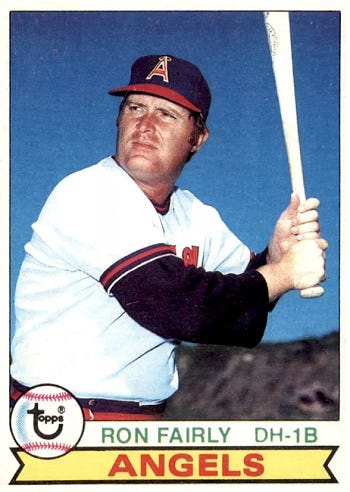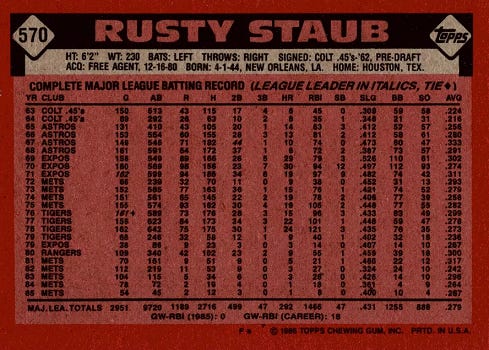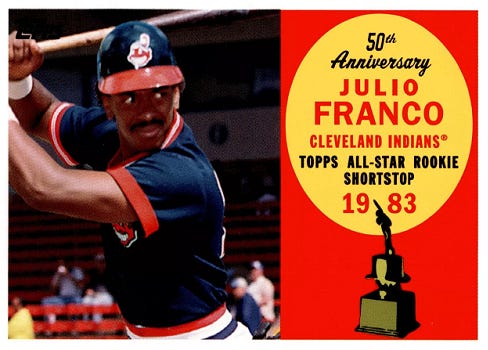5 Baseball Cards that Worked Hard Like You
Carrying all that ink on your back is a tough row to hoe!
Look, it’s Labor Day weekend, so I know there’s a good chance you’re doing something fun or laborious instead of reading the weekly babble here.
But that’s OK — all the goodness that unfolds below will be waiting in your inbox whenever you get back to it. Even if that’s after summer has unofficially ended.
And when you do get back to it, you can celebrate these baseball cards of baseball guys who punched the clock every day for years and years and years but who either never got much attention in the process or who have been largely forgotten today.
You know, like the rest of us who celebrate Labor Day by trying to get a bit of a breather from the grind.
1979 Topps Ron Fairly (#580)
Ron Fairly started his big league career with the Los Angeles Dodgers in 1958, just months after they moved from Brooklyn. He was just 20 years old when he debuted and would after a scant 69 games in the minors.
He spent 1959 with the Dodgers, then most of 1960 back on the farm before landing back in L.A. in September.
From that month through September 23, 1978, though, Fairly was in the majors. Along the way, he also played for the Expos, Cardinals, A’s, Blue Jays, and — finally — the Angels.
Pretty much right back where he started.
Also along the way, Fairly played in 2442 games, collected 1913 hits, clubbed 215 home runs, and made two All-Star teams — in 1973 with Montreal and in 1977 with Toronto.
Those were pretty much the only “official” accolades Fairly picked up, but just the fact that teams kept putting him out there until he was 40 says a lot.
So does the back of his career-capper 1979 Topps baseball card:
1986 Topps Rusty Staub (#570)
Most of what I said about Fairly above also fairly describes Rusty Staub, but Le Grand Orange played even longer — 23 years in all.
Staub was also much more decorated, with six All-Star selections and MVP votes in seven different seasons. He also led the majors with 44 doubles in 1967 as a member of the Astros and hit four home runs for the Mets in the 1973 postseason (three in the NLCS, one in the World Series).
Staub is at least a minor legend among old-time fan bases pretty much everywhere he played, except maybe Texas. Every once in awhile, someone even pipes up with a “Rusty should be in the Hall of Fame missive.”
That’s not too likely at this point, but he did end up with more than 2700 hits and nearly 300 home runs. And his 2951 games played definitely qualify him for this lunch-pail list. In fact, that mark still stands 14th on the all-time list. Of the top 24, the only ones not in the Hall of Fame are pariah guys Pete Rose, Barry Bonds, Rafael Palmeiro, and Omar Vizquel, a guy who’s not yet eligible (Albert Pujols), and Staub.
His career-capper is another optometrist’s nightmare.
2008 Topps 50th Anniversary Topps All-Star Rookie Team Julio Franco (#AR19)
Franco debuted for the Phillies back in 1982 and then spent most of the rest of the decade building his star with the Indians. The Tribe traded him to Texas after the 1988 season, when he had won his first Silver Slugger award and picked up MVP votes for the first time.
With the Rangers, Franco was an All-Star three straight years, culminating with a huge 1991. That summer, he led the majors with a .341 batting average. After two less stellar seasons in Arlington, Franco had a nice rebound season for the White Sox in 1994. He hit .319, won another Silver Slugger, and finished eighth in American League MVP voting that strike-shortened year.
Things got spotty from there for Franco.
He played his age-36 season (1995) in Japan, came back to Cleveland in 1996, and split 1997 between the Indians and Brewers. He played one game with the Tampa Bay Devil Rays in 1999, jammed in between two stints in Japan and one in Mexico.
Just when it looked like Franco was done in the majors, though, he showed up in Atlanta and stayed there from 2001 through 2005 — he was 47 when that season ended. Then it was off to the Mets in 2006 before splitting 2007 between the Mets and Braves.
That would finally be Franco’s last hurrah in the majors, at least so far. He did play in Mexico in 2008 and had a seven-game run with the independent Fort Worth Cats in 2014 at age 55.
All told, Franco spent parts of 23 seasons in the big leagues, hitting .298 and collecting nearly 2600 hits. He’s another amazing grinder from an earlier generation (mine, roughly) who won’t get much love as the years continue to fly by
But Franco stuck it out for more years than almost any mere mortal could be expected to do. He doesn’t have a full contemporary career-capper that I could find, but this one is sort of a hybrid quasi-rookie/career-capper. (If you want to see his real rookie card, check out this article — it might surprise you!)
1961 Topps Mickey Vernon (#134)
Vernon played for parts of 20 seasons in the big leagues and would have notched two more if it weren’t for World War II — he missed 1944 and 1945 serving in the military.
When he was on the field, it was mostly as the first baseman for the Washington Senators in the 1940s and 1950s, which meant he was witness to a lot of bad teams. He wasn’t a huge power guy, especially for a first sacker, but he did club 172 home runs in his career.
After just a pair of nods early in his career, Vernon reeled off four straight All-Star appearances once he turned 35, then added another at age 40 in 1958 when he was with the Indians.
What I really like about this card, though, Vernon’s 1961 Topps issue, is that it neatly bridges the two sides of his career.
He retired after the 1959 season, then spent 1960 as the first base coach for the Pirates. When rosters expanded on September 1 that year, Pittsburgh added Vernon to the mix as an active player, and found his way into nine games down the stretch for the pennant winners.
Then, in 1961, Vernon returned to Washington as the manager of the new Senators, who sprang to life as an expansion team when the original Sens moved to Minnesota after the 1960 season.
2015 Topps Update LaTroy Hawkins (#US361)
I wanted to get at least one pitcher on this list, and there were plenty of candidates.
Jesse Orosco, Mike Stanton, and John Franco stand 1-2-3 on the list of most pitching appearances ever, and none of them are Hall of Famers.
On the starting side of the ledger, Tommy John was a strong candidate since he not only pitched 26 years in the bigs and put up more than 4700 innings, but he did more than half of that work after his original left arm fell off.
In the end, though, I settled on LaTroy Hawkins for a few reasons.
One was that this list needed some balance since the guys above are so last century (though Franco forged into the 21st).
For another, Hawkins stands tenth on the all-time appearances list, with 1045. What’s more, his 1467 1/3 innings are more than all of the guys above him except for Dennis Eckersley and Hoyt Wilhelm.
Hawkins just kept coming back, too, year after year, going wherever he could find work. And always doing a pretty darn good job once he got there.
And yet, he hardly ever got a chance to close, never led a league in any major statistical category, and never made an All-Star team.
Definitely the perfect arm for our little team here.
This Hawkins card is quite a career-capper as it doesn’t include his stats with the Blue Jays in 2015 when he was 42, but it does show him with the Jays. That’s a win in my book.
—
Alright, I’ve belabored this point enough. So now it’s over to you.
Who are your favorite work-a-day ballplayers? I’d love to hear your picks.
Thanks for reading, and I hope your summer blowout is as blowout-y or mellow as you hoped it would be.
Thanks for reading.
—Adam














Great article!! Try reading Nolan Ryan's stats on the 1993 Topps Micro set. Impossible.
Great post!
Another one of these that would qualify is the Jim Kaat 1983 Topps card #672.
I remember when I first saw the reverse of that card, I needed a magnifier to see the stats he compiled since 1959. Incredible!
Thanks!